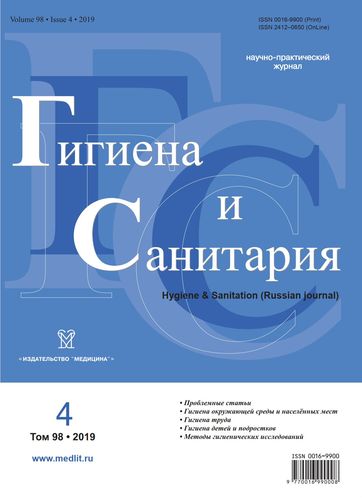On the evaluation of working conditions in open area in the winter season
- Авторлар: Rakhmanov R.S.1,2, Gadzhiibragimov D.A.3, Bakhmydov G.G.3, Alikberov M.K.1, Tarasov A.V.1
-
Мекемелер:
- Nizhny Novgorod Research Institute for Hygiene and Occupational Pathology of the Federal Service for Supervision of Consumer Rights Protection and Human Well-Being
- Privolzhsky Research Medical University
- Medical-Sanitary Service of Military unit 51410
- Шығарылым: Том 98, № 4 (2019)
- Беттер: 424-427
- Бөлім: OCCUPATIONAL HYGIENE
- ##submission.datePublished##: 14.10.2020
- URL: https://kld-journal.fedlab.ru/0016-9900/article/view/640233
- DOI: https://doi.org/10.47470/0016-9900-2019-98-4-424-427
- ID: 640233
Дәйексөз келтіру
Толық мәтін
Аннотация
Introduction. The evaluation of the impact influence of weather and climatic conditions on humans in cold (winter) period was done since there was not the method of evaluation of working conditions according to the degree of harmfulness and danger. Also, the sanitary norms and rules 2.2.4.3359-16 does not contain the method of risk evaluation of the influence of factors upon the human organism.
Material and Methods. The authors evaluated the influence of various combinations of ambient temperature and wind speed upon under conditions of IV climatic region in I zone (the Republic of Dagestan – at an altitude of 4 m., 1040 m. and 1661 m above sea level and the Kaliningrad region) according to wind cooling. It was found a possible discomfort sensation at an average speed of winds and temperatures (wind cooling index (WCI) more 763,7 Kcal/m2) as well as overcooling risk in combinations of average temperature and maximum wind speed, an average speed of the wind and the minimum temperature. Maximum wind speeds in combination with minimal temperatures exceeded WCI threshold by 1,25-2,1 times. It should be noted that the studies were conducted under conditions of an increased humidity which had a negative influence upon the human organism, but in combination with the high wind speed and low temperatures, the effect might be more considerable.
Results. In accordance with the method, in attachment 17 in manual Р 2.2.2006-05, working conditions were classified as harmful. By calculation on indices of the minimal temperature and maximum wind speed, indices of equivalent temperatures reached up to considerable values. Probably, the use of the method does not prove its value.
Conclusion. The fixing of complex influence (in the cold period) of air velocity, ambient temperature, air humidity and detecting of health risk due to weather and climatic conditions remain a topical theoretical and practical problem.
Авторлар туралы
Rofail’ Rakhmanov
Nizhny Novgorod Research Institute for Hygiene and Occupational Pathology of the Federal Service for Supervision of Consumer Rights Protection and Human Well-Being; Privolzhsky Research Medical University
Хат алмасуға жауапты Автор.
Email: noemail@neicon.ru
ORCID iD: 0000-0003-1531-5518
MD, Ph.D., DSci., head of the Laboratory of evaluation of real nutrition of workers, Nizhny Novgorod research institute for hygiene and occupational pathology of the Federal Service for Supervision of Consumer Rights Protection and Human Well-Being, Nizhny Novgorod, 603950, Russian Federation.
e-mail: raf53@mail.ru
РесейD. Gadzhiibragimov
Medical-Sanitary Service of Military unit 51410
Email: noemail@neicon.ru
ORCID iD: 0000-0003-1048-5235
Ресей
G. Bakhmydov
Medical-Sanitary Service of Military unit 51410
Email: noemail@neicon.ru
ORCID iD: 0000-0001-6399-4960
Ресей
M. Alikberov
Nizhny Novgorod Research Institute for Hygiene and Occupational Pathology of the Federal Service for Supervision of Consumer Rights Protection and Human Well-Being
Email: noemail@neicon.ru
ORCID iD: 0000-0003-1775-9382
Ресей
A. Tarasov
Nizhny Novgorod Research Institute for Hygiene and Occupational Pathology of the Federal Service for Supervision of Consumer Rights Protection and Human Well-Being
Email: noemail@neicon.ru
ORCID iD: 0000-0001-5749-1216
Ресей
Әдебиет тізімі
- Ivanov V.P., Ivanova N.V., Polonikov A.V. Medical ecology. SPb.: SpetsLit.; 2012. 320 p. (in Russian)
- Vorob’eva L.V., ed. Hygiene, sanology, ecology: Teaching aids. SPb.: SpetsLit.; 2011. 255 p. (in Russian)
- Gabovich R.D., Poznanskiy S.S., Shakhbazyan G.X. Hygiene. 3-e ed. Kiev: Vishcha shkola, Golovnoe izd-vo; 1984.320 s. (in Russian)
- Bardov V.G. Hygiene of climate: teaching aids on general hygiene. Kiev; 1990.136 p. (in Russian)
- Vishnevskaya E.P., Kozlova T.A., Rumyantseva G.I., Cherkasov E.F. General hygiene. M.: Meditsina; 1973. 328 p. (in Russian)
- Federal’nyy zakon RF, 28.12.2013 № 426-FZ «On special evaluation of working conditions» (Rossiyskaya gazeta, published 30.12.2013., red. 01.05.2016). (in Russian)
- Order of Ministry for Labour and Social Issues on 24.01.2014 № 33 «On approval method of fulfillment of special evaluation of working conditions, classifier of harmful and (or) dangerous occupational factors, form of report on fulfillment of special evaluation of working conditions and instructions how to complete it» (zaregistrirovano v Minyuste Rossii 21.03.2014 № 31689). (in Russian)
- SanPiN 2.2.4.3359-16 «Sanitary-epidemiological requirements to physical factors at working places”/ Resolution of head state sanitary physician RF 21.06.2016. N 81. (in Russian)
- Manual on hygienic evaluation of work environment factors and working process. Criteria and classification of working conditions R 2.2..2006-05. Bulletin of normative and methodical documents of Gossanepidnadzora. M., 2005: 3-144. (in Russian)
- Novozhilov G.N., Lomov O.P. Hygienic evaluation of microclimate. L.: Meditsina, L.O.; 1987.112 p. (in Russian)
Қосымша файлдар







